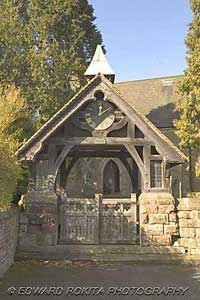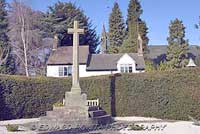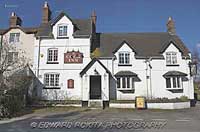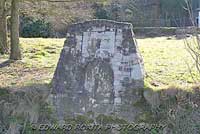Clifton is a charming Derbyshire village situated a mile and a quarter south west of Ashbourne. Along with Compton it once formed a township in the parish of Ashbourne until the 1890's when Compton was taken in by Ashbourne, leaving Clifton in the Morleston and Litchurch Hundred.
Clifton is a scattered village, once straddling the A515 from Collycroft to Lodge Farm near the Nestle factory, until the bypass was built in the 1970's. It contains numerous cottages of individual character and over the last 50 years or so, two new housing estates have been built. The oldest building in the village is thought to be the Cock Inn. It has a well stocked shop cum post office, village school, golf course and a cricket club.

Clifton church |

Clifton cross |

Cock Inn at Clifton |

Clifton goal |
On Watery Lane there stood a corn mill built by J. Brindley. On the site of the mill a stone plinth was erected as a goal for the Royal and Ancient game of Football which is still played in and around Ashbourne on Shrove Tuesday and Ash Wednesday. Depending on which side of the Henmore Brook you were born dictates which team you support, 'Upards' or 'Downards'. See Shrovetide Football for more information.
In the 1880's much of Clifton and Sturston (where the other goalpost is) was owned by the Smith family who made their fortune in cheese-mongering. They were great benefactors, donating money for playgrounds, a cricket pitch, the Holy Trinity Church and its windows. At various times they lived at Clifton Hall which has now been divided into 2 properties.
The Holy Trinity church was built in 1845 by H.I.Stevens. The apse and bell tower were added later, in 1868, by Slater and Carpenter.
The Hanging bridge is a pictureque structure with 5 pointed arches situated some three quarters of a mile from the village centre. It was probabily built in the 14th century though it was partly concealed by widening in 1937.
On one of the aproach roads into Clifton from Snelston is a mound known as Margery Bower. It is thought to be a site where Cromwell's Roundheads, after the battle of Naseby in 1645, set up their cannons to attack the retreating Royalists at Ashbourne. A cannon ball in St Oswald's church, Ashbourne is supposed to be a relic from this time.
The resident population of Clifton and Bradley in mid 1998 was 2000 people, 3 per cent of the population of Derbyshire Dales local authority. 22 percent of Clifton and Bradley’s population in mid 1998 were aged under 16, 53 per cent were aged between 16 and 59 and 24 per cent were aged 60 and over.